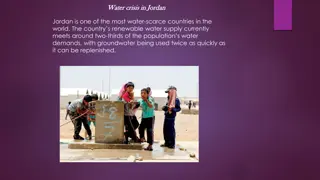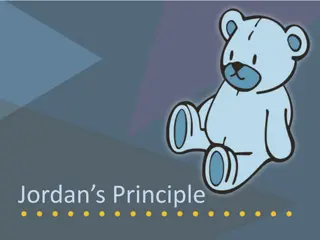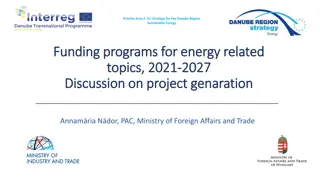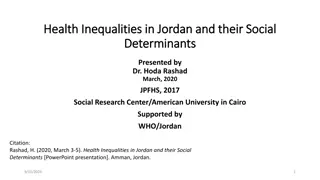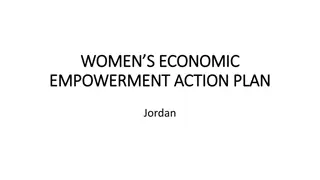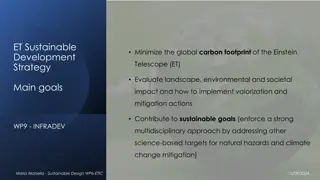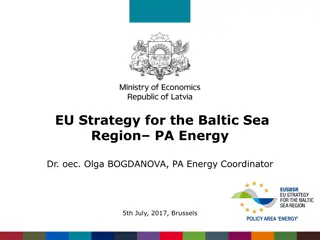Energy Strategy and Challenges in Jordan: Towards Sustainable Development
The Eleventh Meeting of the Oslo Group on Energy Statistics discussed the energy sector in Jordan, highlighting challenges such as population growth, energy demand, and high energy costs. Jordan aims to diversify energy resources, reduce oil dependency, and enhance environmental protection through its 2015-2025 energy strategy. The country faces an energy crisis impacting its economy, but also holds potential in renewable energy utilization, oil and gas exploration, and energy networks connectivity.
Download Presentation

Please find below an Image/Link to download the presentation.
The content on the website is provided AS IS for your information and personal use only. It may not be sold, licensed, or shared on other websites without obtaining consent from the author.If you encounter any issues during the download, it is possible that the publisher has removed the file from their server.
You are allowed to download the files provided on this website for personal or commercial use, subject to the condition that they are used lawfully. All files are the property of their respective owners.
The content on the website is provided AS IS for your information and personal use only. It may not be sold, licensed, or shared on other websites without obtaining consent from the author.
E N D
Presentation Transcript
Eleventh Meeting of the Oslo Group on Energy Statistics 8-11 May 2017,Stockholm Sustainable Development Goals Energy in Jordan Abdel-motaleb Al-nugrsh 1
Contents Introduction Energy Strategy Energy Projects 2
Challenges of Energy Sector High increasing in the population (9.9)million in 2016. High growth rate in Energy and Electricity Demand. High growth rate in Energy Brice. High growth rate in Energy Bill. 3
Energy Strategy ( 2015-2025) Main Goals: Diversifying the energy resources Increasing the share of local resources in the energy mix. Reducing the dependency on imported oil Enhancing environment protection This will be achieved through: Maximizing the utilization of domestic resources (oil shale, natural gas, etc.) Expanding the development of renewable energy projects Generating electricity from nuclear energy 4
Energy Policy Ensuring security of Sustainable supply of all energy forms. Diversification of energy sources. Enhancing the efforts to utilize the local energy resources. Increasing the share of the renewable energy in the total mix of primary energy. Enhancing environmental protection. 5
Theeffects of the energy crisis in Jordan - The heavy burden of energy costs on the Jordanian economy. - Imported energy consume 7.3 % of the GDP value in 2016. - Increased the levels of public debt and increase the budget deficit . - Decreased the rates of economic growth, and development programs. - Causing negative impact on the competitiveness of industries and exports of the kingdom in regional and global markets. - Energy crisis has negative impact on social life . (poverty, unemployment, poor income distribution, lack of sense of social justice). 6
Potential and Strong Points - Jordan is considered as a hub and transit country and can play a major role linking oil, gas and electricity networks among the region. Gas Pipelines Oil Pipelines Electricity Networks - Jordan has a huge potential of Renewable Energy utilization (wind & solar/ solar radiation intensity 7 Kwh/m2 per day, wind speed 11 m/s). - Jordan has a huge potential of energy resources (Oil shale, Uranium). - Jordan has potential of oil and gas exploration. - Completion of the legal and regulatory frame work, legislative of the energy sector. 7
Short-Term Solutions Construction of LNG Jetty at Aqaba port and connect with main Arab Gas Pipeline to diversify the natural gas resources. Increase the country s strategic of oil and oil products storage capacity. - Contraction of strategic storage capacities for light oil product with a capacity of 250-300 thousand ton, and 8 thousand ton for LPG in the middle of Jordan . - Construction of 100 thousand ton storage capacity for crude oil in Aqaba, and 6 thousand for LPG . 8
Medium and Long Term Solutions Continue the implementation of the country s energy strategy through:- Maximizing the utilization of domestic resources (oil shale, natural gas, etc.). Expanding the development of renewable energy projects. Generating electricity from nuclear energy. Enhancing regional interconnection of electricity and promoting Jordan as a regional hub. 9
Renewable Energy Targets Promoting the Renewable Energy Source to share10% in 2020 :- 600 - 1000 MW Wind Energy 300 - 600 MW Solar Energy 30 - 50 MW Waste to Energy All RE projects shall enjoy the tax exemptions applicable to conventional IPP projects. Any citizen can produce his/her needs of electricity from renewable energy resources. 10
Reference Price List RE source Tariff Fills/ kWh Wind Energy 80 Solar Energy (CSP) 135 PV 100 Bio mass 90 Bio gas 60 11
Renewable Energy Projects About 1335 MW of Wind and Solar PV projects are currently under development in Jordan as follows: 117 MW / Tafila Wind / Direct Proposal/ Operational 10 MW / Philadelphia Solar PV/ Direct Proposal/ Operational 90 MW / Al Fujaij Wind / Direct Proposal/ Under Construction 200 MW / Solar PV/ Round I Operational 330 MW / Wind / Round I/ Under Financial Close 200 MW / Solar PV/ Round II/ Under Financial Close 1335 MW 80 MW / Ma an Wind / GCC Grant/ Operational 103 MW/ Qweira Solar PV/GCC Grant/ Under Construction 200 MW/ Masdar/ Solar PV/ Governmental Initiative Under FC 5 MW/ Azraq Solar PV/ Spanish Grant/ Operational
Small Scale RE Projects Small scale consumers has been given the opportunity to generate their own electricity and sell the extra (if any) to the distribution utilities. This covers consumers from different sectors like residential, industrial, commercial, agricultural etc. 17 MW total installed capacity (rooftops). 80 MWApproved. 13
Generating Electricity from Waste A power plant will be built for direct burning of solid waste with capacity of 50 MW in the middle of the Kingdom. Bio-gas power plant will be built in Gabawi landfill in 2020 with capacity of 25 MW. This in addition to the project of Jordan Biogas Company in Rusaifa Landfill with capacity of 3.5 MW operation from 1998. 14
Achievements of RE Projects in 2016 Generating Electricity from RE Wind 387.5 Gwh Solar 266.3 Gwh Hydro 41.1 Gwh Bio Gas 6.5 Gwh Renewables Contribution to Electricity : 4% 15
Renewable Energy Regulatory Framework Renewable Energy and Energy Efficiency Law The Law issued in April 2012, allows for the Direct Proposal Submissions of projects for generating electrical power and connecting to the grid. By-Laws and Regulations for Investment The by-laws and regulations related to renewable energy projects for electricity generation have been issued by the Energy and Mineral Regulatory Commission, especially the Reference Price List which include the indicative prices for each type of Renewable Source. 16
Renewable Energy Regulatory Framework Energy Efficiency By-Law Issued on 14 November 2012 , where SWHs are mandatory as of April 2013 for new buildings, ESCOs market has to be licensed and regulated , as well as Labeling is mandatory to all Electrical Appliances. Tax Exemptions By-law Recently approved, exempting all Renewable Energy and Energy Efficiency Systems and Equipment's from Sales Tax and Custom duties. Moreover, All Renewable Energy Projects shall enjoy the tax exemptions applicable to Conventional IPP projects. Ongoing Grid Reinforcement Plans by NEPCO The so-called Green Corridor development, to be ready by 2017 to absorb all renewable power.17 transmission line is under
Jordan Renewable Energy & Energy Efficiency Fund (JREEEF) Established in accordance with Renewable Energy and Energy Efficiency Law no. 13 for the year 2012. The Fund s Work Scope Include; Providing the funding necessary for the exploitation of renewable energy sources and the rationalization of energy consumption including small Renewable Energy Facilities including : Grants, Loans Guarantees, & Technical Assistance. Funding of public awareness campaigns. Equity renewable (Innovation). participation energy in or companies energy with promising technologies new efficiency 44
Jordan Renewable Energy & Energy Efficiency Fund (JREEEF) The fund services include the following ; 1. Private Sector. 2. Governmental Entities. 3. NGO s & Non-Profit organization. 4. Local Associations. 5. Natural Persons. The Fund implemented its first PILOT project in cooperation with Jordan River Foundation to install 5000 Solar Water Heating unit through a Revolving Fund for Local Societies in different governorates around Jordan. In 2015: the fund will launch its Strategic Plans and its different Financial Interventions & Funding Schemes in RE & EE covering different sectors. 45
Renewable Energy & Energy Conservation - The target set in the Energy Strategy to increase the share of renewable energy to reach 10% of total energy mix by the year 2020 is becoming achievable. - Jordan is in the process of implementing a rigorous conservation program which has a potential of reducing energy consumption by 20% by 2020. 20
Restructuring the Oil Market The Gov. granted three license for three companies to distribute petroleum products in the kingdom namely: Total Jordan Company Manaseer Oil and Gas Company The Jordanian co. for marketing Petroleum products. owned by JPRC . The marketing companies are able to import 40% of oil product of Jordan s needs. Pricing the petroleum products on a monthly basis until the opening of the market for competition. 21
Status of Crude Oil and Oil Products Projects - Increase the storage capacities of crude oil and oil products in order to secure an adequate strategic stocks of the Kingdom. - Currently inAqaba the construction of: - 100 thousand ton storage capacity for crude oil, The project is excepted to put in operation at the end of 2017. - 6,000 tons of LPG, is also expected to be operational in the second half of 2017. Both are EPC projects awarded to Chinese company (CIDG) 22
Status of LNG project To diversify the source of natural gas, the decision was taken to construct LNG Jetty at Aqaba port and tie in with Arab Gas Pipeline at Aqaba. Floating Storage and Regasification Unit (FSRU) lease agreement was executed on 31 July 2013 with (Golar company). Sales & Purchase Agreement was executed on 21/01/2015 with Shell. Gas Transportation Agreement and Tie in Agreement were signed on 06/03/2014 with (Fajir Company) and will be ready byApril, 2015. LNG Overall project is operational by July 2015. Jordan Started export NG after completion of terminal of LNG inAqaba. 90% of Electricity Generation of the Kingdom based on NG in 2016. 24
Oil Shale Jordan has a huge reserve of Oil Shale which is ranked as the fifth country in the world. Jordan has more than 70 billion tons of near surface proven reserves of more than 7 billion ton oil equivalent. The National Energy included Oil Shale to contribute with 14% of the energy mix in the Kingdom in the Year 2020. Oil Shale can be exploited by three different processes: - Direct burning electricity - Surface retorting to produce oil and - In Situ heating the deeply seated oil shale to produce oil. Strategy has for producing
Oil Shale Current Status & Investment Projects Three Companies signed Concession Agreements Seven Companies signed Memoranda of Understanding MOU
Companies that signed Concession Agreements 1- Jordan Oil Shale Energy JOSE (Estonian/Malasyian /Jordanian) - Ratified as a Special Law in the Year 2010 to develop a surface retort plant in Attarat Um GhudranArea to produce oil with an investment of 6 billion USD 2- Karak International for Oil KIO - Ratified as a Special Law in the Year 2011 to develop a surface retort plant in Al Lajjun area to produce oil with an investment of 1.9 billion USD. 3- SaudiArabian Corporation for Oil Shale SACOS - Ratified as a special law in 2014 to develop a surface retorting plant in Attarat area to produce oil with an investment of 1.8 billion USD.
Companies that signed Direct Burning agreements 1- Attarat Power Company (Estonian/Malaysian/Jordanian) has signed the relative Agreements of an oil shale direct burning power plant in October 2014 in Attarat area to produce 473 MW which forms one sixth of the Kingdom electricity consumption in addition to the technology transfer gained to the local operating labors who will be involved in the project from the construction period to the full operation of the plant. Expected of Operation the end of 2020.
Time-Frame and Estimated Quantities of Shale Oil by the Three Concessioners for the Deeply Oil shale and Surface Retorting 1- Jordan Oil Shale Energy (JOSE): Development Phase I (20.000 barrel/day) Development Phase II (40.000 barrel/day) Pre-Development Phase (Maximum 4yrs) Aug 2018 Aug 2020 July 2015
Time-Frame and Estimated Quantities of Shale Oil by the Three Concessioners for the Deeply Oil shale and Surface Retorting 2- Karak International for Oil KIO : Pre-Development Phase (Maximum 4 yrs) Development Phase I (17.000 barrel/day) Development Phase II (40.000 barrel/day) Development Phase III (60.000 barrel/day) March 2021 March 2016 March 2019 March 2023 3-Saudi Arabian Corporation for Oil Shale SACOS : Pre-Development Phase (Maximum 4 yrs) Development Phase I (2500 barrel/day) Development Phase 2 (30000 barrel/day) 2023 2018 2021
Electricity Generation Independent Power producer Projects Third IPP with a capacity of 573 MW has granted to a joint venture company owned by KEPCO and Mitsubishi. The project was put in operation in 2015. Fourth IPP with a capacity of 240 MW has granted to AES Levant company. The project was put in operation in 2015. 32
Nuclear Power Program Jordan has a comprehensive civilian nuclear power program which includes :- - extraction of natural uranium, - development of programs for human resource, - development and construction nuclear research facilities. -Two nuclear power plants of 1000 MW each, expected to be in operation on 2023 and 2025 respectively. 33
THANK YOU 34



